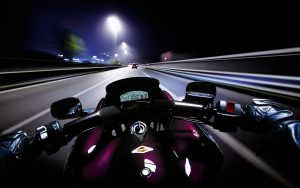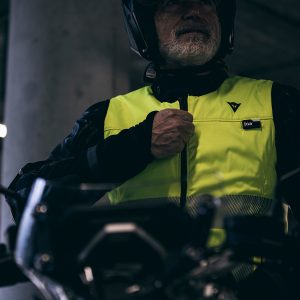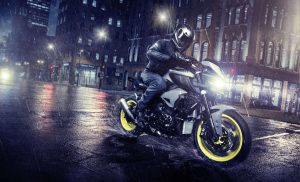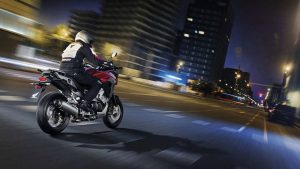

The Hidden Dangers of Motorcycle Riding at Night
With limited visibility comes more cautious riding. Here are several things to be aware of while riding in the night time.
- Drunk Drivers: Statistically speaking, other than the obvious challenges with limited visibility, riding at night poses additional risks from drunk drivers. Hopefully not on your account, but fellow drivers are more likely to have had a drink or two before getting behind the wheel.
- Hidden Obstacles: Beyond other vehicles on the road, the road becomes more hazardous due to obstacles and debris in the road, potholes of any size, loose gravel, manholes, and many other things that become less visible when darkness approaches. They also become more difficult to manoeuvre around. While you may easily see something on the road, moving in your lane of travel can put you on a collision course with something you didn’t see hidden in the darkness.
- Animals: As the saying goes, ‘a deer in the headlights’ is an accurate depiction of animals who freeze under pressure when they look into your headlights. Many preys and scavenger animals tend to come out at night to avoid the risk of active predators in the daytime and/or they are merely nocturnal by nature. Thankfully, most animal eyes will emit a glow and signal their presence to you if you do happen to come across one at night, just in time to avoid their bodies on the road.
- Limited Visibility: There is a significantly higher risk of biker fatalities at night. Make sure you are seen with high visibility clothing (yes we know it’s not fashionable, but it’s needed) and make sure you can see with a clean headlight (you can also upgrade your bulbs if needed) and take your time.
Make Yourself Visible
If visibility is a leading contributor to accidents and fatalities during the nighttime, there are several ways to turn the tide and make motorcycle night riding safer. Here are some ways you can positively influence safety while riding at night:

High Visibility Clothing/Gear – As your body is completely visible to other drivers, take advantage by wearing clothing that is easily seen in the low light levels at night. Studies show found that motorcyclists are 37% less likely to be involved in a motorcycle crash when they are wearing high-visibility or fluorescent clothing. Wearing fluorescent colors, such as neon yellow, green, orange, or even white, will increase your chances of being seen than if you were decked out in all-black gear. Most importantly, be sure that your motorcycle gear has retro-reflective panels that will glow when hit with light from your headlights, as that will be the main distinguishable feature on you while riding.
- If you don’t want to invest in hi-viz gear as you don’t believe you will be needing and/or wearing it often, you can purchase a neon industrial safety vest commonly worn by construction workers. Opt for a neon yellow or orange vest and make sure that it has reflective panels!
Reflective Tape & Decals – For added visibility, stylize your motorcycle and/or your gear with retro-reflective tape that will catch the attention of other motorists.
- For added visibility, stylize your motorcycle and/or your gear with retro-reflective tape that will catch the attention of other motorists. You can purchase a roll of tape in virtually any color imaginable to amp up your gear. Use your creativity when applying the tape, as you can add them along the edge of your bike, on your forks, along with the panniers and saddlebags, or for those looking to take it one step further, on the lip of your wheel rims. Reflective decals are also available as well for those who want to include additional designs on their bikes, armour, or helmet.
Lighting Options – When it comes to lighting on your motorcycle, there are plentiful options available.

- LED Lights: Standard incandescent bulbs are bright, but switching them to an LED light bulb can amplify your visibility from other motorists and allow you to see farther and better at night. LED bulbs can output more light with reduced power from the motorcycle and without the extra heat of a higher wattage incandescent bulb. Just be careful that your motorcycle flasher can compensate for the reduced resistance from adding or changing bulbs to LEDs. You may need to change the flasher on your motorcycle to an electronic flasher instead of a resistance flasher to compensate for the change in bulbs. Here are a few ways to see and be seen better by adjusting your lighting options:
- Brake Light Flashers: You can change out or add to your brake lighting with a flasher that makes your bulb flash multiple times when the brakes are applied. Rather than having a steady light, it will grab the attention of the motorist behind you with a few flashes and then stay steadily illuminated.
- Headlight Modulator: A headlight modulating kit can add some attention from oncoming motorists by pulsing your low beam headlights. With many new cars featuring daytime running lights, your headlight can become lost in a sea of headlights at any point during the day. A pulsing light breaks up the sea of lights and gives you the extra attention you need to stay safe. Although some motorists may find it as a distraction, it just proves that it’s doing its job – you’re being seen!
- Auxiliary Lights: Beyond replacing the OEM bulbs with LED replacements, there are plenty of options available for custom lighting for added visibility to your motorcycle. The type of lighting that you would want to add depends on the purpose you are trying to serve. For example, you can add lights to help you see further down the road for safer night riding, to improve your ability to see when there are foggy conditions, or to brighten up the areas of your peripheral vision. You can add single bulbs up to multiple strips in multiple colors and some kits are even smartphone enabled to change colors at your command!
- High Beams: As a highly debated topic, high beams during your night time riding can be advantageous to motorcyclists. One of the leading causes of accidents are other motorists turning right in front of a motorcycle and so bright high beam lights can alert drivers of their action of cutting off a motorcyclist.
Beyond changing to LED bulbs and adding retro-reflective gear and designs, your unlimited imagination can help with visibility. Stand back and look at your motorcycle. What would catch your eye more? If it catches your attention, it will catch other motorists as well!
Night Vision
Where To Look: Oncoming headlights can be blinding, and since you’re riding a little higher than most cars, they can be especially blinding for you. One option is to look at the far left line at the edge of the road on your side of the road. This can help with the light shining in your eyes and will help keep you going in the right direction and in your lane. Don’t look down and away as it will affect your ability to ride straight in your lane.
Ride Within the Light:
- The lights on our motorcycles extend only so far in front of your bike during the dark hours of the day, meaning your view is limited. Your motorcycle is capable of incredible stopping power and a short distance, but you will require more stopping distance in order to avoid any obstacles that may be up ahead. At night, reduce the speeds traveled because you can’t see miles ahead of you. If you find yourself out-riding your light, it’s time to slow down.
- Use other vehicle headlights as an extension of your own. If you’re following a vehicle ahead, watch for their headlights to show debris in the road, potholes, etc. Also be aware that cars can straddle debris on the road that you can’t, which can be detrimental to your safety. If you see something, be prepared to manoeuvre around it or change lanes to completely avoid it.
Clean Your Visor: One thing to also keep in mind with your visor is that needs to be kept clean. Use a simple cleaning solution with a cotton or microfiber cloth to prevent micro-scratches on your visor that over time can cloud the visor and make vision through it distorted. Cloth towels shouldn’t scratch the visor.
Riding with Tinted Visors or Glasses: Riding with a dark, tinted visor at night is not recommended, but there are variations that can help at night. A yellow-tinted visor/glasses can be worn during low-light hours, such as dusk. For those who don’t want to worry about carrying an extra visor to swap out from daytime to nighttime, there are photochromic visors that adjust to light levels throughout the day. You can also carry an extra pair of clear glasses that you can wear during the nighttime as you ride open visor. There isn’t a one-size-fits-all option that will work for every rider out there, so experiment between options to determine what works best for you.
Make Yourself Heard
“Loud pipes save lives”. You’ve most likely heard this expression at least once. Your exhaust can definitely announce to other motorists that you’re near them, whether you’re coming or going. Although they may hear that you’re nearby, that doesn’t guarantee they can see you, so continue being alert and cautious of your surroundings. Also make sure your exhaust is still within the legal noise limit.
Prepare for the Elements

Dealing With Fog: During the cooler temperatures in the evening and night time, fog can be more prevalent. With fog comes condensation that can add a layer of moisture to your windshield, visor, and rear-view mirrors. This can be conflicting to your ride, as it’s obstructing your ability to see. Be prepared by adding a coat of anti-fogging solution to each surface to prevent or reduce fogging.
Temperature Variations: If you live in an area that sees a lot of fluctuations in temperature, you’re probably aware that preparation is key. While it’s easy to turn the A/C off in the car and crank the heater up when you don’t have that luxury on a motorcycle. You may need to consider wearing a jacket or suit that has a removable thermal liner for the warm weather that can quickly convert to cooler riding gear when it gets humid. Consider carrying an extra pair of gloves for night riding if your daytime gloves won’t be sufficient in keeping you warm. Keep in mind that riding while cold will affect your ability to stay focused on the road and reduces your body’s reaction time so be prepared!
Loss of Traction: Cooler roads provide less traction for your tyres. Not only will cool, wet roads cause an issue, but cool dry roads can be just as concerning. Be mindful of your speed and approach your corners and straightaways with caution.
Additional Safe Riding Tips

- Practice Defensive Riding – One of the best strategies to stay safe is to pretend that you’re invisible. Sometimes you blend in so well with traffic that you pretty much are. Ride defensively and always think of what you can do to stay safe if another driver doesn’t recognize that you are there.
- Be Alert – You should constantly scan between the horizon and your mirrors. Position your mirrors so that you can just use your eyes to see what’s behind you and not have to turn your head to look around you.
- Stay Out of Blind Spots – One of the worst places to ride is in a blind spot of another rider or larger vehicle. They can easily merge or change lanes into you and/or swerve to miss debris in the road and cause an unavoidable collision.
- Use Your Signal – Turn signals are a courteous way to signal to other motorists that you intend to change your course through a lane change or turn. During night riding, they can also grab the attention of another motorist via the flashing lights.
- Increase Driving Distance – When you can’t see clearly in front of your motorcycle, the following distances need to be greater than they usually are. While you can stop far faster than most vehicles on the road, many things can happen quickly during the night riding hours. Add a few extra seconds for reaction time for a potential problem that will far outweigh getting there a few minutes later because of traffic or a need to ride slower.
- Turning/ Cornering Changes – One way to make cornering easier is to try to separate the braking action from turning. Brake the most (if not all) before you commit to a turn. This will give your tyres the most traction available for each action and gives you the most stability.
- Riding in Thirds – Each lane can be split into thirds (left, middle, and right), and generally speaking, are equally important no matter the time of day. Use them as needed to stay safe and avoid anything in the roadway. Each section has an advantage and disadvantage to offer concerning other motorists, debris, passing, etc. There isn’t a right or wrong answer to which you should ride in. Stay safe and seen, period.
Night riding can open you up to a whole new world. You can ride the same stretch of road in the daytime for years and one ride during the night hours can completely disrupt your perspective. With changing scenery comes changing dangers. A small change in your riding gear, small upgrades to your motorcycle, and specific modifications to your riding habits can keep you safe and enjoying your newfound riding scenery. Stay safe and good luck!





